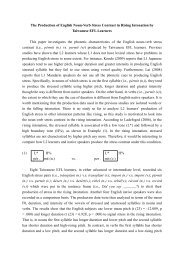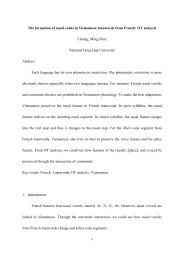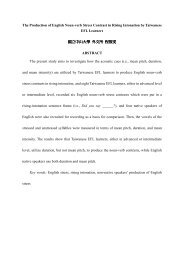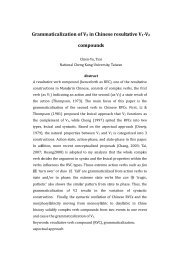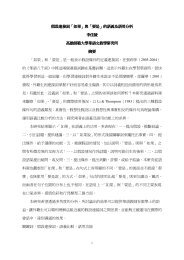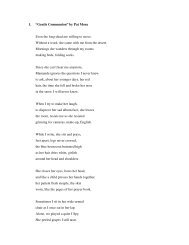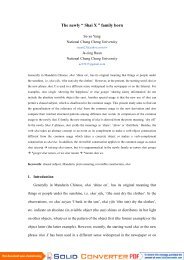Tibetan as a Wh-in-situ language
Tibetan as a Wh-in-situ language
Tibetan as a Wh-in-situ language
You also want an ePaper? Increase the reach of your titles
YUMPU automatically turns print PDFs into web optimized ePapers that Google loves.
<strong>Tibetan</strong> <strong>as</strong> a <strong>Wh</strong>-<strong>in</strong>-<strong>situ</strong> <strong>language</strong>National Ts<strong>in</strong>g Hua UniversityGraduate InstituteOfL<strong>in</strong>guistics吳 濠 丞Howard Wue-mail: hao012250@hotmail.com
<strong>Tibetan</strong> <strong>as</strong> a <strong>Wh</strong>-<strong>in</strong>-<strong>situ</strong> <strong>language</strong>No movement. Not appropriate to Lh<strong>as</strong>a <strong>Tibetan</strong>.■ For and aga<strong>in</strong>st INTERVENTION EFFECTS■ Functional category versus scrambl<strong>in</strong>g and wh-movementInformant:Name: Khenpo Nyiyak (<strong>Tibetan</strong>)Age: 42 (1969/6/25)Khenpo=> 通 過 佛 學 院 學 習 , 認 證 , 考 試 而 來 的 稱 號( 博 士 )Education:Birth place:LanguageSpoken:How manyyears <strong>in</strong>Taiwan?From age 6,7(read<strong>in</strong>g and writ<strong>in</strong>g) to whole lifeQ<strong>in</strong>ghai 青 海Kham, Lh<strong>as</strong>a <strong>Tibetan</strong>, Mandar<strong>in</strong>(<strong>in</strong> simple conversation)Lh<strong>as</strong>a <strong>Tibetan</strong>: start from 1986(<strong>in</strong> India) to now2004 till now, (8~9) years2
<strong>Tibetan</strong> <strong>as</strong> a <strong>Wh</strong>-<strong>in</strong>-<strong>situ</strong> <strong>language</strong>2. Previous Studies & New F<strong>in</strong>d<strong>in</strong>gs <strong>in</strong> <strong>Tibetan</strong>2.1 LF exam<strong>in</strong>ation >Locality:■ Adjuncts <strong>in</strong> <strong>language</strong>s with overt wh-movement cannot be extracted out of an island■ These c<strong>as</strong>es are much worse than sentences <strong>in</strong> which a wh-argument (e.g., an object) isextracted from the same environmentsFor example: (1) a. *<strong>Wh</strong>yi do you wonder whether John left ti?b. *<strong>Wh</strong>yi do you believe the claim that John said Bill left ti?(2) a. ??<strong>Wh</strong>at do you wonder whether John bought?b. ?*<strong>Wh</strong>oi do you believe the claim that John said Mary saw ti?(from L<strong>as</strong>nik and Saito 1992)3
<strong>Tibetan</strong> <strong>as</strong> a <strong>Wh</strong>-<strong>in</strong>-<strong>situ</strong> <strong>language</strong>■The same pattern of contr<strong>as</strong>t can also be found with wh-<strong>in</strong>-<strong>situ</strong> <strong>in</strong> multiple questions. Thatis, we cannot leave wh adjuncts <strong>in</strong>-<strong>situ</strong> <strong>in</strong> an island. In addition, Similar patterns are alsofound <strong>in</strong> <strong>language</strong>s like Mandar<strong>in</strong> Ch<strong>in</strong>ese, which do not have overt wh-movement.For example: (3) Húfei xiAng-zhi dào shéi wèishénme shengqì (?)„Hufei want-know who why get-angry‟a. „Hufei wonders who gets angry why.‟b. „for which x, x a person, Hufei wonder why x gets angry‟c. *what is the re<strong>as</strong>on x, Hufei wonders who gets angry for x‟(cited: Cheng 2009) It can be <strong>in</strong>terpreted <strong>as</strong> a matrix question; it can only be a matrix question <strong>as</strong>k<strong>in</strong>g forwhich person, but not for which re<strong>as</strong>on.However, <strong>in</strong> <strong>Tibetan</strong> we can switch both argument (who) and adjunct (why) around, andthat we f<strong>in</strong>d the same <strong>in</strong>terpretation <strong>in</strong> declarative sentence. As the follow<strong>in</strong>g shows:(4)Nga rang ha ko song ka rec<strong>in</strong>i su kong tsou long re 1Me know PRF why who angry ASP Yes(Declarative)P<strong>as</strong>t„I wonder why gets angry who‟„ 我 想 知 道 誰 為 什 麼 生 氣 ‟1NOTE:„re‟ <strong>in</strong> sentence f<strong>in</strong>al position carries different sense. It can carries the sense of yes-noquestion, third person, have or <strong>in</strong>dicat<strong>in</strong>g a p<strong>as</strong>t event.4
<strong>Tibetan</strong> <strong>as</strong> a <strong>Wh</strong>-<strong>in</strong>-<strong>situ</strong> <strong>language</strong>=>what is the re<strong>as</strong>on x, me wonders who gets angry for x (<strong>as</strong>k<strong>in</strong>g for the re<strong>as</strong>on)Notice: If we switch the argument (who) and adjunct (why) around, the <strong>in</strong>terpretation isstill <strong>as</strong>k<strong>in</strong>g for which re<strong>as</strong>on but not for which person.=> The <strong>in</strong>tonation is chang<strong>in</strong>g <strong>in</strong> this sentence for <strong>as</strong>k<strong>in</strong>g the question■ Example (5) illustrates a typical (ungrammatical) example of an adjunct <strong>in</strong>-<strong>situ</strong> <strong>in</strong> acomplex NP island.(5)*Qiaofeng xihuAn Bótong wèishénme xia de shu?Qiaofeng like Botong why write de bookIntended: „For what re<strong>as</strong>on x such that Qiaofeng likes the book that Botong wrote for x?‟(cited Cheng2009)However, we f<strong>in</strong>d <strong>in</strong> <strong>Tibetan</strong>:(6)Niyak ka re ci ni jigmme yiksuk la kaaki reNeo <strong>Wh</strong>y Jigmme writ<strong>in</strong>g mood___ like have„<strong>Wh</strong>y Neo likes Jigmme‟s writ<strong>in</strong>g?‟„ 尼 奧 為 什 麼 喜 歡 傑 米 寫 的 字 ?’(V+have)Intended: „For what re<strong>as</strong>on x such that Neo likes the letters that Botong wrote for x?‟Here, we f<strong>in</strong>d <strong>in</strong> <strong>Tibetan</strong> that adjunct (<strong>Wh</strong>y) h<strong>as</strong> been scrambled out of the complex NPisland. On the other hand, it is also possible to leave the adjunct (why) <strong>in</strong> complex NP island,5
<strong>Tibetan</strong> <strong>as</strong> a <strong>Wh</strong>-<strong>in</strong>-<strong>situ</strong> <strong>language</strong>and is grammatical <strong>in</strong> Lh<strong>as</strong>a <strong>Tibetan</strong>, yet it is less spoken by people.> 2.2 Selectional Requirements■ It is well-known that different verbs select for different types of complement clauses. For<strong>in</strong>stance, verbs such <strong>as</strong> <strong>as</strong>k require an <strong>in</strong>terrogative complement, while believe must havea declarative complement, and know can take both.Example <strong>in</strong> Mandar<strong>in</strong>:(7)Huangróng xiangxìn Guojìng mai-le shanme?Huangrong believe Guoj<strong>in</strong>g buy-perf what„<strong>Wh</strong>at does Huangrong believe that Guoj<strong>in</strong>g bought?‟(8) Qiáofeng wèn wo Guojìng mAi-le shanme/*shuQiaofeng <strong>as</strong>k me Guoj<strong>in</strong>g buy-perf what/book„Qiaofeng <strong>as</strong>ked me what Guoj<strong>in</strong>g bought./*Qiaofeng <strong>as</strong>ked meGuoj<strong>in</strong>g bought the book.‟(9) Bótong zhidào Huángróng xihuan shéi (?)Botong know Huangrong like whoa. „Botong knows who Huangrong likes.‟b. „<strong>Wh</strong>o does Botong know Huangrong likes?‟(Huang 1982)6
<strong>Tibetan</strong> <strong>as</strong> a <strong>Wh</strong>-<strong>in</strong>-<strong>situ</strong> <strong>language</strong>If <strong>in</strong>-<strong>situ</strong> wh-phr<strong>as</strong>es undergo movement at LF, the selectional requirements of the verbcan be satisfied the same way <strong>as</strong> <strong>in</strong> English.In <strong>Tibetan</strong>, we f<strong>in</strong>d the follow<strong>in</strong>g example:(10)Nga rang Jiggme ki ka re nu na ici yu +reMe Jiggme ERG what bought conj believe have(3 rd )(declarative)‘<strong>Wh</strong>at do I believe that Jigmme bought?‟„ 我 相 信 傑 米 買 了 什 麼 ?‟(11)Niyak ki tsewa la Jigmme ki ka re deb nu songNeo GEN <strong>as</strong>k mood Jigmme ERG what book bought PRF( 動 作 的 聯 繫 詞 )„Neo <strong>as</strong>k me what Jigmme bought?‟*‟Neo <strong>as</strong>ked me Jiggme bought the book‟.‘ 尼 奧 問 我 傑 米 買 了 什 麼 ’Notice: There is an <strong>in</strong>visible me <strong>in</strong> this context.(12)Niyak ki hako ki re Jigmme su la kaaki reNeo GEN know ASP have Jigmme who Mood like have‘Neo knows who Jigmme likes‟ ’<strong>Wh</strong>o does Neo know Jigmme likes?‟„ 尼 奧 知 道 傑 米 喜 歡 誰 ?‟7
<strong>Tibetan</strong> <strong>as</strong> a <strong>Wh</strong>-<strong>in</strong>-<strong>situ</strong> <strong>language</strong>John-top Mary-nom what-acc bought whether who-dat <strong>as</strong>ked Q„<strong>Wh</strong>o did John <strong>as</strong>k t whether Mary bought what?‟b. ??John-wa [Mary-ga nani-o katta ka dooka] Tom-ni tazuneta no?John-top Mary-nom what-acc bought whether Tom-dat <strong>as</strong>ked Q„<strong>Wh</strong>at did John <strong>as</strong>k Tom whether Mary bought t?‟c. ??John-wa [dare-ga nani-o katta ka dooka] Tom-ni tazuneta no?John-top who-nom what-acc bought whether Tom-dat <strong>as</strong>ked Q„<strong>Wh</strong>at did John <strong>as</strong>k Tom whether who bought t?‟He argues that the operator part of the wh-word <strong>in</strong> Japanese mov<strong>in</strong>g to SpecCP). This issupported by data show<strong>in</strong>g that an <strong>in</strong>terrogative clause constitutes an island for S-structure movement(such <strong>as</strong> scrambl<strong>in</strong>g) <strong>in</strong> Japanese. The second level of movement is at LF. (Watanabe‟s proposal thussupports the view that subjacency only constra<strong>in</strong>s overt operations.)=>Watanabe‟s proposal opens up a new way of look<strong>in</strong>g at wh-<strong>in</strong>-<strong>situ</strong>: a non-overt part of awh-element undergoes movement <strong>in</strong> overt syntax.A similar example can be found <strong>in</strong> English:a. <strong>Wh</strong>oi did John <strong>as</strong>k ti [whether Mary bought what]?b. ??<strong>Wh</strong>ati did John <strong>as</strong>k Tom [whether Mary bought ti]?10
<strong>Tibetan</strong> <strong>as</strong> a <strong>Wh</strong>-<strong>in</strong>-<strong>situ</strong> <strong>language</strong>The sentence is grammatical. The standard explanation is that who undergoeswh-movement <strong>in</strong> overt syntax, not cross<strong>in</strong>g any island s<strong>in</strong>ce it orig<strong>in</strong>ates outside of the islandand the second wh-word what only undergoes wh-movement at LF.In <strong>Tibetan</strong>, we found a similar example to Japanese:(17)Niyak ki ke chia su la tsi re [re ma re Jigmme ki ka re nu re]Neo GEN talk who mood <strong>as</strong>k whether Jigmme ERG what bought have„ Neo <strong>as</strong>ked who [whether Jigmme bought what]?‟„ 尼 奧 問 誰 是 不 是 傑 米 買 了 什 麼 ?‟(18)( 是 不 是 )*Su la Niyak ki kechia tsi re [re ma re Jigmme ki kare nu re]<strong>Wh</strong>o Neo GEN talk__ <strong>as</strong>k [whether Jigmme ERG what bought have]( 是 不 是 )*„<strong>Wh</strong>oi did Neo <strong>as</strong>k ti [whether Jigmme bought what]?‟„ 誰 尼 奧 問 是 不 是 傑 米 買 了 什 麼 ?‟In these two examples17 and 18, we found out that although „who‟ orig<strong>in</strong>ate outside ofthe <strong>in</strong>terrogative clause constituent, not violat<strong>in</strong>g any Subjacency effect, it still can not moveto Spec of CP. On the other hand, „what‟ can be moved to Spec of CP by scrambl<strong>in</strong>g. As thefollow<strong>in</strong>g examples show:(19)11
<strong>Tibetan</strong> <strong>as</strong> a <strong>Wh</strong>-<strong>in</strong>-<strong>situ</strong> <strong>language</strong>Niyak ki kechia su la tse re [re ma re Jigmme ki kare nu re]Neo GEN talk who mood <strong>as</strong>k [whether Jigmme ERG what bought have]( 是 不 是 )„ Neo <strong>as</strong>ked who [whether Jigmme bought what]?‟„ 尼 奧 問 誰 是 不 是 傑 米 買 了 什 麼 ‟(20)Kare Niyak ki kechia su la tsi re [re ma re Jigmme ki nu re]<strong>Wh</strong>at Neo GEN talk who mood <strong>as</strong>k whether Jigmme ERG_ bought have„<strong>Wh</strong>at i did Neo <strong>as</strong>k who [whether Jigmme ti bought ]?‟„ 尼 奧 問 什 麼 誰 是 不 是 傑 米 買 了 ‟In 20, I <strong>as</strong>sume that the first level ( sensitive to Subjacency at S-structure movement)„who‟ orig<strong>in</strong>ate outside of the <strong>in</strong>terrogative clause constituent which h<strong>as</strong> not violate anysubjacency effect. On the other hand, on the second level movement „what‟ moves at LFwhich supports what Watanabe (1992) h<strong>as</strong> claimed. (subjacency only constra<strong>in</strong>s overtoperations.)>2.5 Alternatives to Covert wh-Movement, from the approach of M<strong>in</strong>imalist program.Test: No movement: Choice Function.■ Re<strong>in</strong>hart (1998) first argues that there is <strong>in</strong> fact no LF wh-movement <strong>in</strong>volved <strong>in</strong>wh-<strong>in</strong>-<strong>situ</strong> questions■ With no actual wh-movement tak<strong>in</strong>g place <strong>in</strong> syntax or at LF, Re<strong>in</strong>hart addresses thequestion of how <strong>in</strong>-<strong>situ</strong> wh-words can be <strong>in</strong>terpreted.Example <strong>in</strong> Mandar<strong>in</strong>:12
<strong>Tibetan</strong> <strong>as</strong> a <strong>Wh</strong>-<strong>in</strong>-<strong>situ</strong> <strong>language</strong>(21)Zhangsan mai-le shanmeZhangsan buy-perf whata. „which x, x a th<strong>in</strong>g, such that Zhangsan bought x‟b. „which x, such that Zhangsan bought x, x a th<strong>in</strong>g‟If we <strong>as</strong>sume that the wh-word shenme „what‟ <strong>in</strong> (21) h<strong>as</strong> not undergone traditionalwh-movement at LF, the <strong>in</strong>terpretation <strong>in</strong>dicated <strong>in</strong> (21a) is not e<strong>as</strong>ily atta<strong>in</strong>ed. Instead, wewould have (21b). In other words, if an <strong>in</strong>-<strong>situ</strong> element is left <strong>in</strong>-<strong>situ</strong> and we <strong>in</strong>terpret itwithout any extra mechanism (with simple absorption or unselective b<strong>in</strong>d<strong>in</strong>g), then therestriction of the wh-element also rema<strong>in</strong>s <strong>in</strong>-<strong>situ</strong>.We have a similar <strong>Tibetan</strong> example <strong>as</strong> the follow<strong>in</strong>g; however we do not f<strong>in</strong>drestrictions with wh-element rema<strong>in</strong> <strong>in</strong> <strong>situ</strong>. Instead, we get the wide scope read<strong>in</strong>g. As thefollow<strong>in</strong>g show:22.Niyak ki kare nu reNeo GEN what bought have‘<strong>Wh</strong>at did Neo buy?‟„ 尼 奧 買 了 什 麼 ’ X „which x, such that Neo bought x, x a th<strong>in</strong>g‟ √ „which x, x a th<strong>in</strong>g, such that Zhangsan bought x‟S<strong>in</strong>ce I have only one example <strong>in</strong> counter argu<strong>in</strong>g aga<strong>in</strong>st „no movement approach‟, it is13
<strong>Tibetan</strong> <strong>as</strong> a <strong>Wh</strong>-<strong>in</strong>-<strong>situ</strong> <strong>language</strong>not solid enough. Further <strong>in</strong>vestigation to the choice function is still needed.>2.6 For or aga<strong>in</strong>st INTERVENTION EFFECTS■ Beck (1996), work<strong>in</strong>g under the <strong>as</strong>sumption that there is LF wh-movement, shows that <strong>in</strong>German an <strong>in</strong>-<strong>situ</strong> wh-phr<strong>as</strong>e <strong>in</strong> a scope-mark<strong>in</strong>g sentence or <strong>in</strong> a multiple questioncannot be c-commanded by a negation.(23)a. ??Wen hat niemand wo gesehen?<strong>Wh</strong>om h<strong>as</strong> nobody where seen„<strong>Wh</strong>ere did nobody see whom?‟In <strong>Tibetan</strong>, we have a similar pattern. As the follow<strong>in</strong>g show:(24)Niyak ki kare nu ki mareNeo Gen what bought ASP not„Neo what did not buy ?‟„ 尼 奧 沒 有 買 什 麼 ?(25)However it is also not possible for a negation to proceed and c-command <strong>in</strong>-<strong>situ</strong>-wh-phr<strong>as</strong>e <strong>in</strong>Lh<strong>as</strong>a <strong>Tibetan</strong>. As the follow<strong>in</strong>g show:*NIyak ki mare kare nu kiNeo Gen not what bought ASP*„Neo did not buy what?‟14
<strong>Tibetan</strong> <strong>as</strong> a <strong>Wh</strong>-<strong>in</strong>-<strong>situ</strong> <strong>language</strong>„ 尼 奧 沒 有 什 麼 買 ?‟(26)Or*Mare Niyak ki kare nu kiNot Neo Gen what bought ASP*‘Didn‟t Neo buy what?‟*„ 沒 有 尼 奧 什 麼 買 ?‟It seems to support what Beck (1996) h<strong>as</strong> claimed. On the other hand, it also supportswhat Beck and Kim (1997) h<strong>as</strong> claimed <strong>in</strong> which scrambles the wh-phr<strong>as</strong>es over the<strong>in</strong>terveners cancels the <strong>in</strong>tervention effect.(27)a. *Amuto muôs-ûl sa-chi anh-<strong>as</strong>s-ni? (=Beck & Kimanyone what-acc buy-chi not do-P<strong>as</strong>t-Q 1997, ex. 2a,b)b. Muôs-ûli amuto ti sa-chi anh-<strong>as</strong>s-ni?what-acc anyone buy-chi not do-P<strong>as</strong>t-QAs the follow<strong>in</strong>g example shows <strong>in</strong> <strong>Tibetan</strong>:(28)Kare Niyak ki nu ki mare ___<strong>Wh</strong>at Neo Gen bought ASP not„<strong>Wh</strong>at Neo didn‟t buy?‟„ 尼 奧 沒 有 買 什 麼 ‟15
<strong>Tibetan</strong> <strong>as</strong> a <strong>Wh</strong>-<strong>in</strong>-<strong>situ</strong> <strong>language</strong>It is also possible to f<strong>in</strong>d Modals which do not block wh-<strong>in</strong>-<strong>situ</strong>. In this c<strong>as</strong>e, it is similarto Mandar<strong>in</strong> Ch<strong>in</strong>ese and English. As the follow<strong>in</strong>g <strong>in</strong> <strong>Tibetan</strong> show:(29)Tsi rang sang n<strong>in</strong> deb nuka tso ki remare deb de kare reYou tomorrow book buy go ASP MODAL book CONNECT whatYes‘Are you go<strong>in</strong>g to buy a book tomorrow, yes or not? <strong>Wh</strong>at is the book?‟„ 你 明 天 是 不 是 要 去 買 書 , 是 什 麼 樣 的 書 ?In this sentence, it is divided <strong>in</strong>to two parts of speech. As the def<strong>in</strong>ition of „Modalswhich do not trigger <strong>in</strong>tervention‟ <strong>in</strong> Mandar<strong>in</strong> and English is not clear. The unclear part iswhether it is b<strong>as</strong>ed on one part of speech or two parts of speech. However, the above <strong>Tibetan</strong>sentence is just try<strong>in</strong>g to show that it is possible for a Modal <strong>in</strong> a sentence which does nottrigger <strong>in</strong>tervention effect.3. Functional category versus wh-movement and scrambl<strong>in</strong>gFukui (1989: 101) notes that English h<strong>as</strong> subject-verb agreement, which leads him topostulate that English h<strong>as</strong> the category of functional heads, <strong>in</strong>clud<strong>in</strong>g C, which projects thespecifier <strong>in</strong>to which a wh-phr<strong>as</strong>e moves. Hence English h<strong>as</strong> overt wh-movement.The presence of INFL, and the concomitant agreement with its specifier, requires thesubject to raise to this specifier position.But Japanese lacks anyth<strong>in</strong>g that resembles agreement; it h<strong>as</strong> no subject-verb agreement,for example. Japanese therefore lacks the category of functional categories, hence lacks16
<strong>Tibetan</strong> <strong>as</strong> a <strong>Wh</strong>-<strong>in</strong>-<strong>situ</strong> <strong>language</strong>wh-movement.Kuroda (1988) h<strong>as</strong> a similar proposal, although he <strong>as</strong>sumes that Japanese h<strong>as</strong> functionalheads and specifiers that project from them. Kuroda <strong>in</strong>troduces a parameter b<strong>as</strong>ed on thenotion of what he calls “X-Agreement.”Kuroda’s parameter (1988: 10)Languages are parameterized <strong>as</strong> to whether X-Agreement is forced or not.Objects (and PPs), which are likewise licensed by particles, hence also not dependent onfunctional heads, move freely above this subject.For Kuroda, the possibility of scrambl<strong>in</strong>g <strong>in</strong> Japanese arises from the fact that thespecifier of IP need not be filled due to the non-forced agreement nature of the <strong>language</strong>.(cited: Miyagawa 2004:4)Now, let‟s consider from the <strong>Tibetan</strong> perspective:<strong>Tibetan</strong> h<strong>as</strong> also Subject verb agreement; nonetheless it is less restricted <strong>as</strong> English.17
<strong>Tibetan</strong> <strong>as</strong> a <strong>Wh</strong>-<strong>in</strong>-<strong>situ</strong> <strong>language</strong>We can <strong>in</strong>fer from the verb follow<strong>in</strong>g particle y<strong>in</strong> (first and second person) and re (thirdperson).As the follow<strong>in</strong>g shows:(30)Tse rang kabar la tsoki y<strong>in</strong>You where Mood go 2P (second person)„<strong>Wh</strong>ere are you go<strong>in</strong>g?‟„ 你 要 去 哪 裡 ?‟(31)Ko kabar la tsoki reHe where Mood go 3P (third person)„<strong>Wh</strong>ere is he go<strong>in</strong>g‟„ 他 要 去 哪 裡 ?‟However, sometimes we can use re <strong>as</strong> first person <strong>as</strong> well, but it‟s not often.It seems like <strong>Tibetan</strong> also h<strong>as</strong> the functional categories (agreement), however it stilllacks wh-movement <strong>as</strong> w<strong>as</strong> proven from the previous examples. It is contrary to theperspective from what Fukui (1989: 101) h<strong>as</strong> noticed.Beside, scrambl<strong>in</strong>g is found <strong>in</strong> <strong>Tibetan</strong>. However, unlike Japanese <strong>in</strong> which Objects (andPPs) and Objects <strong>in</strong> Turkish( Miyagawa 2004) can move freely above the subject. It isusually the Subject that above the Object <strong>in</strong> <strong>Tibetan</strong>.Nonetheless, it is not necessarily contradict Kuroda‟s approach <strong>in</strong> which he suspend[s]judgment…<strong>as</strong> to whether or not, or how, X-Agreement is conceptually comb<strong>in</strong>ed with18
<strong>Tibetan</strong> <strong>as</strong> a <strong>Wh</strong>-<strong>in</strong>-<strong>situ</strong> <strong>language</strong>phenomena of agreement <strong>in</strong> the more usual sense of the term, for example, gender andnumber agreement between a noun (subject) and a (f<strong>in</strong>ite) verb”(Kuroda 1988: 10).4. Conclusion>Lh<strong>as</strong>a <strong>Tibetan</strong> is a <strong>Wh</strong>-<strong>in</strong>-<strong>situ</strong> <strong>language</strong>!■ No overt wh-movement is found■ Scrambl<strong>in</strong>g is found■ The <strong>in</strong>terpretation from Selectional Requirements is different from English andCh<strong>in</strong>ese.■ Subjancency effect is respected at different level which supports the claim byWatanabe (1992).■ Different pr<strong>in</strong>ciple and parameters of functional category with regard to scrambl<strong>in</strong>gor wh-movement is found <strong>in</strong> Lh<strong>as</strong>a <strong>Tibetan</strong>.19
<strong>Tibetan</strong> <strong>as</strong> a <strong>Wh</strong>-<strong>in</strong>-<strong>situ</strong> <strong>language</strong>References (Partial):Cheng, L.L.-S (2009).<strong>Wh</strong>-<strong>in</strong>-<strong>situ</strong> from the 1980s to now. Language and L<strong>in</strong>guistics Comp<strong>as</strong>s, 3 (3), pp. 767-791.Cheng, L.L.-S (2003)<strong>Wh</strong>-<strong>in</strong>-<strong>situ</strong>. Glot International, 7 (4), pp. 103-109.Cheng, L.L.-S (2003)<strong>Wh</strong>-<strong>in</strong>-<strong>situ</strong>. Glot International, 7 (5), pp. 129-137.Cheng, L.L.-S & Rooryck, J.E.C.V. (2000)Licens<strong>in</strong>g <strong>Wh</strong>- <strong>in</strong> <strong>situ</strong>. Syntax, 3, pp. 1-19.Shigeru Miyagawa (2004).“<strong>Wh</strong>-<strong>in</strong>-<strong>situ</strong> and Scrambl<strong>in</strong>g <strong>in</strong> the Context of Comparative Altaic Syntax,”Proceed<strong>in</strong>gs of the First Workshop on Altaic Formal L<strong>in</strong>guistics, MIT Work<strong>in</strong>gPapers <strong>in</strong> L<strong>in</strong>guistics. Spr<strong>in</strong>g 2004.Pesetsky, David. 1987.<strong>Wh</strong> <strong>in</strong> <strong>situ</strong>: Movement and unselective b<strong>in</strong>d<strong>in</strong>g. In Representation of (In)def<strong>in</strong>iteness, eds.Eric Reuland and Alice Ter Meulen, 98-129. Cambridge, M<strong>as</strong>s: MIT Press.Tsai, Wei-Tien Dylan. 1994a.On nom<strong>in</strong>al islands and LF extractions <strong>in</strong> Ch<strong>in</strong>ese. Natural Language and L<strong>in</strong>guistic Theory12:121-175.Watanabe, Akira. 1992a.Subjacency and S-structure movement of wh-<strong>in</strong>-<strong>situ</strong>. Journal of E<strong>as</strong>t Asian L<strong>in</strong>guistics1:255-291.王 志 敬 著 : 藏 語 拉 薩 口 語 語 法 北 京 市 : 中 央 民 族 大 學 , 1994.胡 坦 著 : 藏 語 研 究 文 論 北 京 市 : 中 國 藏 學 , 2002[ 民 91].胡 坦 著 : 拉 薩 口 語 讀 本 胡 坦 , 索 南 卓 噶 編 北 京 巿 : 民 族 , 1999.張 怡 蓀 : 藏 漢 大 辭 典 張 怡 蓀 主 編 北 京 巿 : 民 族 , 1985.20



